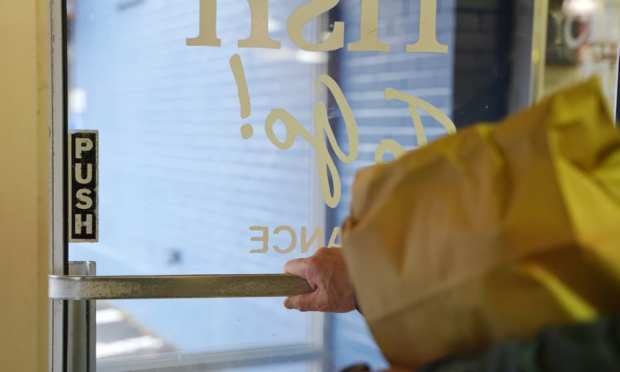Restaurants Turn To Grocery And Meal Kits To Survive

While there are almost no areas of the economy that have not been affected by the COVID-19 epidemic, few have been harder hit than the restaurant industry, which has shut down entirely nearly overnight. A mere 22 days ago, 82 percent of Americans were eating in restaurants regularly, according to PYMNTS data. As of today, given the wave of stay-at-home orders and mounting consumer anxiety about the outbreak, no one is eating in restaurants.
There was an early hope that those consumers who weren’t eating out would instead order in and either get delivery or curbside pick-up. And while any number of eateries have adapted their businesses to make it easier to carry their meals out, as PYMNTS has learned in talking to restaurateurs, in most cases that just isn’t a sufficient solution.
Zoku Sushi CEO Charlie Yi explained to Karen Webster in a digital roundtable discussion that his business was already delivery-only, so the shutdown of eat-in dining hasn’t been an issue for him. However, the fact that the New York City office workers who were the bulk of his clientele are now totally absent has been an insurmountable obstacle.
“Those workers who once sat in their offices, they’ve been sent home and are now sitting in their home offices, so they’re physically not there to consume our food,” Yi said.
And even for those who are still within ordering proximity of dining establishments from their homes, it seems they aren’t doing nearly as much online ordering as was initially hoped. It’s not that they didn’t move online – according to our most recent data, the number of consumers interacting digitally with restaurants has more than tripled over the last several weeks, from 6 percent to 20 percent. But, concerned about their home finances and having more time on their hands to perfect their cooking skills, those consumers are opting to order meals much less than they once were: 93 percent report eating from restaurants less often than they did in a pre-pandemic world.
And so restaurants big and small are rolling out a host of new ideas and add-ons to supplement their incredibly sluggish core business. Most, it seems, are attempting to do this by stepping away from the “luxury” of prepared foods and more toward the practical needs of customers shut into their homes.
Bamboo Asia, a small restaurant chain operating throughout San Francisco’s financial district, is one of many Bay Area businesses that have seen its customer base largely evaporate overnight – and about two days of experimenting with curbside pickup revealed that this strategy would not pick up the slack from its lost lunch crowd.
And so, noted CEO Sebastiaan Van De Rijt, the business has pivoted toward meal kits, on the premise that the offering would fill a unique niche opening in the market.
“We launched sous vide meal kits, which are essentially family meals where everything is all ready to be cooked for you,” he said. “The packaging that consumers bring into their homes has also been sous vide prepared, and so is sterilized against any bacteria and viruses.”
And it’s not just indie chains that are pulling big pivots to stay alive in an incredibly hostile environment. Responding to a loss of about half of its business and rising consumer demand for certain staples, Panera Bread is experimenting with life as a basic bodega. The restaurant is now letting customers order bread, bagels, milk, yogurt, cream cheese and fresh produce as part of an initiative that kicked off earlier this week. Those orders can be grabbed via Panera’s site or Grubhub, for pickup or delivery.
Waffle House has not turned to groceries – instead, it is leaning heavily on its online portal, which existed pre-COVID-19 and has been the internet’s preeminent destination for Waffle House schwag for the better part of a decade.
Tragically, however, for those kept home from the nation’s most persistent purveyor of waffles, DIYing the experience is off the menu for the time being. Waffle House has sold out of mix. The mix was added to the website relatively recently, enabling people to get a taste of the Waffle House while trapped in their homes. The company has said it will be available again in about a week.
For hash browns – smothered, covered, cubed, chunked and otherwise – customers are still on their own, as Waffle House has yet to figure out how to digitize that offering.
And if you’re craving a higher-end cuisine prepared by someone else under the tutelage of an Ina Garten YouTube video? Good news: According to CNN, in bustling metros, Michelin-starred restaurants are wading into the world of takeout and delivery in all kinds of ways. Family-sized meals offered at discount prices, as well as meal kits, have been particularly popular among well-known and often exclusive eateries like Canlis in Seattle, Chicago’s Next and Roister. But as Nick Kokonas, co-owner of The Alinea Group (which owns Next and Roister), noted in an interview with CNN, though the menu items change often, on any given day, they are only serving one thing.
“Instead of offering a giant carryout menu of 80 items, it’s much better to come up with something very, very awesome, precise and simple to execute,” he said.
Or at least as simple to execute as anything is, in a world where consumers have cut their restaurant consumption by over 90 percent due to a viral pandemic that shows no signs of ending anytime soon.
Which means, we suspect, the parries and pivots within the food industry will continue, as restaurants try to stay one step ahead of the crisis that seems bent on eating them up.
